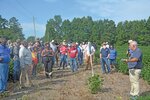


On September 8, a multi-racial crowd of almost 100 farmers from across the southeast, including Allendale, gathered in Bowman for the National Black Growers Council’s Field Day at Mahogany Farms. In addition to celebrating Black farmers across the southeast, the event featured the latest updates on corn, cotton and soybean growing techniques, as well as agricultural technology.
The National Black Growers Council (NBGC) unifies Black farmers, who have seen massive losses in land and wealth over the last century. In 1920, there were nearly one million Black farmers in the United States. Recent agricultural census statistics show that there are less than 46,000, and in the 20th century, Black farmers lost $326 billion worth of land. The decline is the result of racism in agricultural lending practices, the monopolization of agriculture, among other factors.
“If you had 100 farmers in a room, ten of those farmers would be row crop farmers, and out of those ten, one of them would be Black,” said Phillip Haynie, NBGC chairman. “As a Black community, the row crop farmer number has dwindled down tremendously.”
Pests & crop management
For any farmer that grows corn in the region, one persistent issue is fungi, which can destroy entire fields of corn when conditions are favorable for spore growth.
Two of the most common types of fungi discussed at the field day were grey leaf spot and southern rust (sclerotinia is also an issue for farmers). While grey leaf spot is a widespread fungi that destroys farmers’ crops around the world, southern rust is limited to the region, hence the name. Grey leaf spot affects a field of corn by discoloring the husks during periods of high heat and humidity, leaving large lesions in an ear of corn.
At the event, farmers went out to the fields of Mahogany Farms to learn about different options for managing the effects of fungi. Although fungicides do have negative effects on nearby ecosystems, they can be an effective way to manage fungal destruction of corn. In addition to fungi, one issue that was discussed was the effects of mildew on cotton, which cause lesions on cotton plants and are an issue for South Carolina farmers.
New advancements in agricultural technology were presented at the event. Some of these advancements include increases in fuel efficiency and upgrades that can connect tractor sprayers and cotton harvesting machines to the internet.
“As a grower, there’s only so many things that you can control,” said Travis Joslin, a member of John Deere’s marketing team. “So to be in control of one of those input costs, by being a little bit more efficient on your fuel is definitely nice.”
USDA agricultural loans
The United States Department of Agriculture has created a flurry of different grants and loans directed at young farmers, Black farmers and female farmers. These grants are made to outcompete the private market rate for agricultural loans by offering lower rates.
At the event, Laurie Funderburk, state executive director of the USDA’s Farm Service Agency South Carolina Office, told the crowd of farmers about the loans currently available. Under the Inflation Reduction Act, financial assistance is available for Black farmers who experienced discriminatory lending practices by the USDA. Funderburk said USDA representatives are currently trying to improve outreach into farming communities to increase awareness of its new loans.
“Our loan programs are a good option for farmers given market rates right now,” Funderbunk said. “So, we try to get out as much as we can. For any of our county office folks, if there’s an event, they go out [into the community].”